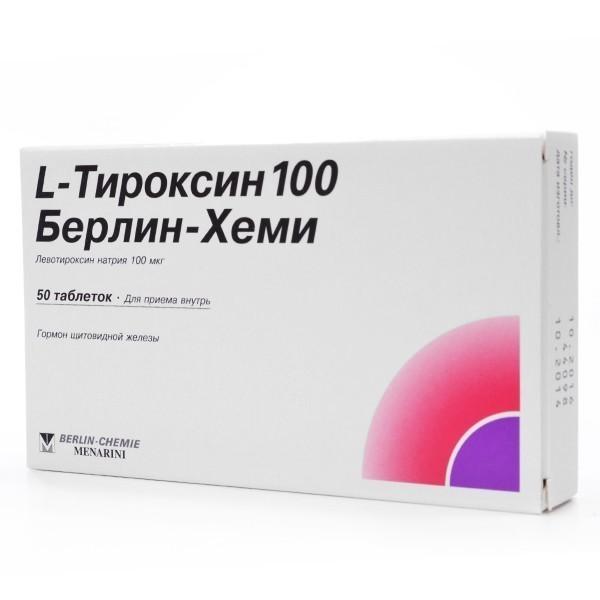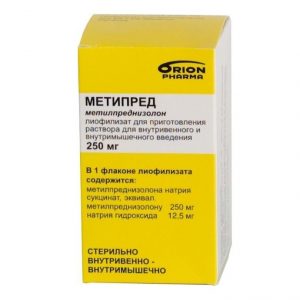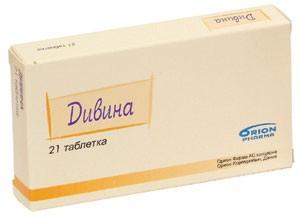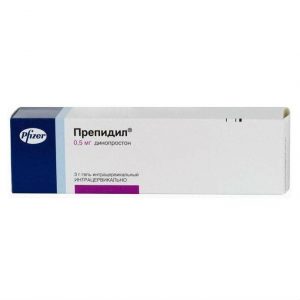Description
Release form
Tablets are white or white with a slightly yellowish tinge of color, round, slightly convex, with a notch on one side and embossed 100 on the other.
Packing
25 pcs – blisters (2) – packs of cardboard.
Pharmacological action
Synthetic preparation of thyroid hormone, levorotatory thyroxine isomer. After partial conversion to triiodothyronine (in the liver and kidneys) and transition to body cells, it affects the development and growth of tissues, and metabolism.
In small doses, has an anabolic effect on protein and fat metabolism. In medium doses, it stimulates growth and development, increases the oxygen demand of tissues, stimulates the metabolism of proteins, fats and carbohydrates, and increases the functional activity of the cardiovascular system and central nervous system. In high doses, it inhibits the production of TSHP of the hypothalamus and TSH of the pituitary gland.
The therapeutic effect is observed after 7-12 days, during the same time the effect persists after discontinuation of the drug. The clinical effect of hypothyroidism manifests itself in 3-5 days. Diffuse goiter decreases or disappears within 3-6 months.
Pharmacokinetics
Absorption
After oral administration, levothyroxine is absorbed almost exclusively from the upper small intestine. Absorbed up to 80% of the dose taken. Simultaneous eating reduces the absorption of levothyroxine. Serum Cmax is reached approximately 5-6 hours after ingestion.
Distribution of
Binds to serum proteins (thyroxin-binding globulin, thyroxin-binding prealbumin and albumin) by more than 99%. In various tissues, approximately 80% of levothyroxine is monodeiodized to form triiodothyronine (T3) and inactive products.
Metabolism
Thyroid hormones are metabolized mainly in the liver, kidneys, brain and muscles. A small amount of the drug is subjected to deamination and decarboxylation, as well as conjugation with sulfuric and glucuronic acids (in the liver).
Excretion
Metabolites are excreted in the urine and bile.
T1 / 2 is 6-7 days.
Pharmacokinetics in special clinical cases
With thyrotoxicosis, T1 / 2 shortens to 3-4 days, and with hypothyroidism lengthens up to 9-10 days.
Indications
Hypothyroidism
euthyroid goiter
as a replacement therapy and for prevention of goiter recurrence after resection of the thyroid gland
thyroid cancer (after surgical treatment)
diffuse toxic goiter: after reaching the euthyroid state or in combination with as a diagnostic tool during the thyroid suppression test.
Contraindications
Hypersensitivity to the drug
untreated thyrotoxicosis
acute myocardial infarction
acute myocarditis
untreated adrenal insufficiency.
Caution is advised to prescribe a drug for coronary heart disease (atherosclerosis, angina pectoris, a history of myocardial infarction), arterial hypertension, arrhythmia, diabetes mellitus, severe long-term existing hypothyroidism, malabsorption syndrome (dose adjustment may be required).
Use during pregnancy and lactation
During pregnancy and breastfeeding, therapy with a drug prescribed for hypothyroidism should continue. During pregnancy, an increase in the dose of the drug is required due to an increase in the level of thyroxin-binding globulin. The amount of thyroid hormone secreted with breast milk during lactation (even during treatment with high doses of the drug) is not enough to cause any disturbances in the baby.
The use of the drug in combination with thyreostatic drugs during pregnancy is contraindicated, because administration of levothyroxine may require an increase in doses of thyreostatics. Since thyreostatics, unlike levothyroxine, can penetrate the placental barrier, hypothyroidism may develop in the fetus.
During breastfeeding, the drug should be taken with caution, strictly at the recommended doses, under the supervision of a doctor.
Composition
1 tab.
levothyroxine sodium 100 μg
Excipients:
calcium hydrogen phosphate dihydrate,
microcrystalline cellulose,
carboxymethyl starch sodium (type A),
dextrin,
long chain partial glycerides.
Dosage and administration
The daily dose is determined individually depending on the indications.
L-Thyroxine Berlin-Chemie in a daily dose is taken orally in the morning on an empty stomach, at least 30 minutes before a meal, drinking a tablet with a small amount of liquid (half a glass of water) and not chewing.
When performing hypothyroidism replacement therapy for patients younger than 55 years old in the absence of cardiovascular diseases, L-thyroxine Berlin-Chemie is prescribed in a daily dose of 1.6-1.8 mcg / kg body weight for patients older than 55 years or with cardiovascular disease – 0.9 mcg / kg body. With significant obesity, the calculation should be done on the ideal body weight.
Initial stage of replacement therapy for hypothyroidism
Patients without cardiovascular disease younger than 55 years of age Initial dose:
women – 50-100 mcg / day,
men – 50-150 mcg / day
Patients with cardiovascular disease or older than 55 years of age. Initial dose – 25 mcg / day.
Increase by 25 mcg with an interval of 2 months until the normalization of TSH levels in the blood.
If the symptoms of the cardiovascular system appear or worsen, correct the treatment of cardiovascular diseases.
Recommended doses of thyroxine for the treatment of congenital hypothyroidism
Age Daily dose of thyroxine (μg) Dose of thyroxine based on body weight (μg / kg)
0-6 months 25-50 10-15
6-24 months 50-75 8-10
from 2 to 10 years old 75-125 4-6
from 10 to 16 years old 100-200 3-4
> 16 years old 100-200 2-3
Indications Recommended doses L-Thyroxine Berlin-Chemie (mcg / day)
Treatment of euthyroid goiter 50-200
Prevention of relapse after surgical treatment of euthyroid goiter 50-200
In the treatment of thyrotoxicosis 50-100 srdl Suppressive therapy for thyroid cancer 150-300
Thyroid suppression test 4 weeks before the test 3 weeks before the test 2 weeks before the test 1 week before the test
50-75 75-100 150-200 150-200 200-200
For accurate dosing of the drug the most appropriate dosage of L-thyroxine Berlin-Chemie should be used ( 50, 75, 100, 125 or 150 mcg).
In severe long-term existing hypothyroidism, treatment should be started with extreme caution, with small doses from 25 mcg / day, the dose is increased to the maintenance dose at longer time intervals – by 25 μg / day every 2 weeks, and the level of TSH in the blood is more often determined. With hypothyroidism, L-thyroxine Berlin-Chemie is taken, as a rule, throughout life.
With thyrotoxicosis, L-thyroxine Berlin-Chemie is used in combination therapy with thyreostatics after reaching the euthyroid state. In all cases, the duration of drug treatment is determined by the doctor.
For infants and children up to 3 years old, the daily dose of L-Thyroxine Berlin-Chemie is given in one dose 30 minutes before the first feeding. The tablet is dissolved in water until a thin suspension is prepared immediately before taking the drug.
Side effects
When using the drug according to the indications in recommended doses under the supervision of a doctor, side effects are not observed.
With hypersensitivity to the drug, allergic reactions can be observed.
Drug Interaction
Levothyroxine enhances the effects of indirect anticoagulants, which may require a reduction in their dose.
The use of tricyclic antidepressants with levothyroxine can lead to increased antidepressant activity.
Thyroid hormones may increase the need for insulin and oral hypoglycemic drugs. More frequent monitoring of blood glucose is recommended during the start of treatment with levothyroxine, as well as when changing the dose of the drug.
Levothyroxine reduces the action of cardiac glycosides. When co-administered with cholestyramine, colestipol and aluminum, the hydroxide reduces the plasma concentration of levothyroxine by inhibiting its absorption in the intestine.
When used with anabolic steroids, asparaginase, Tamoxifen may have a pharmacokinetic interaction at the level of protein binding.
When co-administered with phenytoin, salicylates, clofibrate, furosemide, high levels of levothyroxine and T4 unrelated to plasma proteins are increased.
Somatotropin when used concomitantly with levothyroxine can accelerate the closure of epiphyseal growth zones.
Phenobarbital, carbamazepine and rifampicin may increase the clearance of levothyroxine and may require increased doses.
Estrogens increase the concentration of thyroglobulin-related fraction, which may reduce the effectiveness of the drug.
Amiodarone, aminoglutethimide, PASK, ethionamide, antithyroid drugs, beta-blockers, carbamazepine, chloral hydrate, diazepam, levodopa, dopamine, metoclopramide, lovastatin, somatostatin affect the synthesis, secretion, distribution and metabolism of the drug.
Overdose
Symptoms typical of thyrotoxicosis: palpitations, heart rhythm, heartache, anxiety, tremor, sleep disturbance, sweating, decreased appetite, weight loss, diarrhea.
Treatment: it may be recommended to reduce the daily dose of the drug, a break in treatment for several days, the appointment of beta-blockers. After the side effects have disappeared, treatment should be started with a lower dose of caution. It is not recommended to appoint anti-thyroid agents.
Storage conditions
The drug should be stored out of the reach of children at a temperature not exceeding 25 ° C.
Expiration
2 years.
Active ingredient
Sodium levothyroxine
pharmacy terms and conditions
prescription
dosage form
dosage form
tablets
Berlin-Chemie / Menarini Germany




